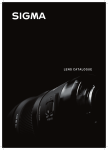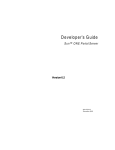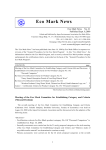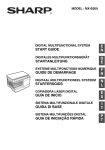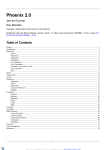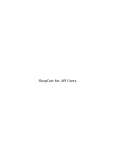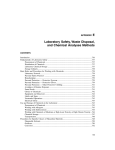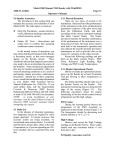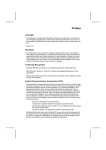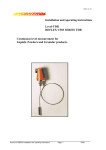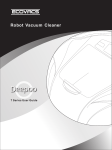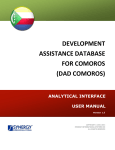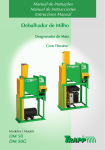Download Paper 9 - IGES Publications
Transcript
H. SATO Eco-Labelling and Green Procurement Schemes for IT-Products: The Japanese Approach 1. Introduction Shipments of personal computers in Japan are rising every year, and reached about 10 million units in 1999. At the same time, the importance of environmental impacts is also growing—impacts caused by the consumption of energy and resources and the generation of waste connected with this large and growing market. In a survey conducted by in September 1999 the Green Purchasing Network (GPN) asked major local governments and corporations about their efforts to purchase environmentally friendly products. Following the number of respondents who mentioned paper products and office supplies, 43 percent said they tried to look for “green” products when purchasing copiers and printers, while the number was 29 percent for personal computers. Significantly, more organizations listed personal computers than the year before, and it is expected that in the future this category of green purchasing will grow rapidly. 2. Eco-labeling and Procurement Schemes At present there are three eco-labeling or procurement schemes in Japan for information technology (IT) products: the Eco Mark criteria for personal computers, established in September 2000; the GPN’s Purchasing Guidelines for personal computers and printers; and the International Energy Star Program standards for standby energy consumption of IT products and copiers. In addition, two more schemes will be introduced in the future in Japan. One is a program promoted by national governmental bodies based on the Green Purchasing Law which was enacted in May 2000, for which procurement standards including IT products are currently being considered. Another is an environmental labeling system for personal computers, which the Japan Electronic 1/30 H. SATO Industry Development Association plans to introduce in the spring of 2001. These initiatives are described below. 2.1 Eco Mark Program The Eco Mark Program is an environmental labeling system created in 1989, operated by the Japan Environment Association under the direction of the Environment Agency. Currently over 4,000 products are certified with the Eco Mark, which is the only ISO Type I label in Japan and is recognized by over ninety percent of the public. Until recently paper products and items used in daily life were the main items for certification, but office equipment and IT products are now also being added due to their growing presence and environmental importance. Certification criteria for copiers were set in 1999, and applications for certification of personal computers started after the criteria were set in September 2000, following two years of discussion. The certification criteria for personal computers were developed based on consideration of the German Blue Angel program. This was done with international harmonization of standards in mind due to the ubiquitousness of personal computers worldwide, and the possibility of the mutual recognition of standards between Eco Mark and Blue Angel labels in the future. Still, many of the criteria differ from those of the Blue Angel program due to the need to reflect different standards and circumstances in Japan. Certification Criteria for Personal Computers The products targeted for Eco Mark certification include desktop and notebook personal computers, monitors, keyboards, and mouses. The principal certification criteria relating to the environment can be broadly placed in the following five categories: 1. Design for recycling (including design for long-life use) 2. Collection and recycling systems 3. Chemical substances 4. Energy consumption 5. Noise 2/30 H. SATO Design for recycling includes such things as the main body consisting of one type of material, and the potential to disassembled the product using common tools. The criteria for long-life use include the potential to upgrade and add functions, modular design, stocking of repair parts for five years or more, and the existence of a system to subcontract repairs. The collection and recycling category includes a system to receive used products and re-use or recycle them, regardless of whether the service carries a charge or is free. The chemical substances category includes the main body not containing plastics which contain halogens, cadmium, lead, or carcinogenic substances; and batteries not containing cadmium, lead, or mercury, etc. The energy consumption category includes conforming to the International Energy Star Program, and meeting efficiency standards set under Law Concerning the Rational Use of Energy, etc. 2.2 Green Purchasing Guidelines The GPN is a private non-profit organization established in 1996 based on a proposal by the Environment Agency that governmental bodies, corporations and consumers should promote green purchasing. It plays a central role in Japan, with over 2,200 members, including 1,700 corporations, more than 300 local governments in 90 percent of Japan’s prefectures, and 250 consumers’ groups and environmental non-governmental organizations. In order to promote green purchasing, the GPN conducts seminars and symposiums around the country, holds product exhibitions and other events, awards excellent organizations, and carries out research. The most important pillars of its activities, however, are its “Green Purchasing Guidelines” and “Environmental Data Books for Product Selection.” The purchasing guidelines for each category of product consist of lists of items that should be considered from the environmental perspective when purchasing. The Environmental Data Books consist of reference tables for comparison of environmental information on products, based on the purchasing guidelines. The GPN emphasizes the provision of information for purchasers, in contrast to the Eco Mark program, which is a system of certifying products. To date, purchasing guidelines have been established and Environmental Data Books published for copiers, refrigerators, washing machines, air conditioners, 3/30 H. SATO automobiles, paper products, stationery/office supplies and office furniture, as well as for personal computers and printers. Purchasing Guidelines for Personal Computers The GPN purchasing guidelines for personal computers were set in November 1997 and partially revised in December 1998. They target both desktop and notebook models, and also cover monitors, keyboards, mouses, and modems when they are sold as part of a package. Below are the seven guidelines: 1. The product should have low power consumption when in operation. The consumption should be in accordance with the Law Concerning the Rational Use of Energy. 2. The product should have a function that shifts it to a low-power mode when unused for a certain period of time, and power consumption in that mode should be low. 3. The product should have the capacity for upgrading and expansion in order to make a longer useful life possible. 4. The product should be designed to facilitate recycling and re-use of component parts. 5. The manufacturer should promote the collection and re-use of used parts from its products. 6. Recycled plastic should be used in the product. 7. The accompanying user’s manual should be made using recycled paper. These guidelines are all accompanied by background explanations and written in a way that non-experts in computers or environmental fields can understand. Based on these guidelines, the Environmental Data Book provides basic product specifications and prices, as well as the following information: energy efficiency, compliance with the International Energy Star Program, electrical consumption under the low power mode, presence of memory expansion slots and maximum 4/30 H. SATO memory capacity, presence of expansion board and card slots, recyclable design, the use of recycled plastics and the use of recycled paper in user’s manual. In addition to these items, the Data Books provide information on the use of brominated fire retardant and the use of PVC plastic in the main body, though this is not included in the purchasing guidelines. The Data Book for personal computers is revised at least once per year in principle, and latest edition carries information on 338 products. Purchasing Guidelines for Printers The GPN purchasing guidelines for copiers, printers and facsimile machines were first set in November 1996 and include nine items, of which the following six apply to printers: 1. The product should automatically switch to a low power mode if not used for a certain period of time. 2. It should be able to print on both sides of a page. 3. Its ozone emissions during operation should be low. 4. It should be designed so that it can be disassembled after the end of its life and parts can be easily re-used or the materials recycled. 5. If selenium is used in a photosensitive drum, it should be properly recovered and recycled. 6. Used toner cartridges should be properly collected and recycled. Based on these guidelines, the Environmental Data Book provides the following information: compliance with the International Energy Star Program, power consumption under the low power mode, recyclable design, capacity to print on both sides of pages, ozone emissions (whether or not they are below 0.04 mg/m3), whether selenium is used and a recovery system exists, existence of a collection and recycling system for toner cartridges. 5/30 H. SATO 2.3 International Energy Star Program The International Energy Star Program is an international program that aims to reduce electrical power consumption of products when they are not in use. In Japan the program is applied to computers, displays, printers, facsimile machines, copiers, multifunctional devices and scanners. The governmental Agency of Natural Resources and Energy determines standards and operational rules in Japan, and the quasi-governmental Energy Conservation Center operates the program. The Energy Star standards were also referred to for the Eco Mark and GPN purchasing guidelines, and have become the de facto standards in this country for standby electrical consumption. Standards for Computers Standards for computers apply to personal computers, workstations, network computers, and all-in-one-systems (which include notebook computers with the computer and display in one unit). Mobile units that have power supplied only from batteries are excluded. Low-power mode standards and the amount of time to switch to that mode are set for each type of device, and these are upgraded as progress is made in energy efficiency. Energy efficiency standards for the low power mode are gradually being made stricter, as shown below. Type of Computer Models with maximum Low Power Mode Consumption for Computers Shipped before Sept 1999 Sept 99 to June 2000 after June 2000 -30 W -30 W -15 W -60W -45W -35W consumption rating of 200 watts All-in-one systems For displays, besides a rating of 15 watts or less for power consumption in the low power mode, a standard for a “deep sleep” mode of 8 watts or less was added for products that were shipped in April 1998 or later. 6/30 H. SATO Standards for Printers Standards for the low power mode and waiting time before switching to that mode depend on the printing speed of printers. Currently, the rating is 15 watts or less for printers that print seven or fewer pages per minute, 30 watts or less for eight to fourteen pages per minute, and 45 watts or less for products that print more than fourteen pages per minute. Color printers and ink jet printers follow these same standards, whereas laser and LED printers have ratings of 45 watts or less. For products shipped after November 2000, new standards will be applied that are considerably more rigorous than previous ones: 10, 20, and 30 watts or less for printers slower than 10, 20 and 30 pages per minute, respectively. 2.4 Basic Green Procurement Policies of the Government In May 2000, a law known as the Green Purchasing Law was enacted based on a non-partisan bill proposed by parliamentarians. This law makes it obligatory for ministries, agencies and institutions of the national government, including branch offices, to implement green procurement. It imposes obligations on local governments to make similar efforts. With the national government accounting for 4.4 percent and local governments for 13.4 percent of Japan’s gross domestic product—for a total of 17.8 percent—their procurement activities have an enormous impact on the market and business. Under this law the government is required to specify items to target for green procurement, and all national governmental bodies are required to set and strive to achieve procurement objectives for those items at least, and to publicize the results on a yearly basis. Connected with this, the government is to determine “green product” assessment criteria for the specified items. These criteria have attracted considerable attention. They are to be set in January 2001, for implementation in April, and it is possible that personal computers and printers will be included. Work is already under way to consider criteria for personal computers, and even if they are not settled in January, it is certain that they will be added later. The details of the assessment criteria are not yet clear, but it is expected that they will take into account the three sets of green purchasing standards described above. 7/30 H. SATO 2.5 JEIDA’s Environmental Labeling The Japan Electronic Industry Development Association (JEIDA), whose members include Japan’s major personal computer manufacturers, has decided to create its own Environmental Labeling System for Computers. This initiative came about as the association observed the recent growth of green purchasing and the establishment of Eco Mark criteria. It is a collaborative initiative by the industry to launch a convincing environmental labeling system, and is expected to begin in the spring of 2001. The JEIDA approach is not a system of labeling based on third-party certification; rather, it is envisioned that manufacturers will apply an environmental label using their own judgement, based on JEIDA standards. The details of the standards are not yet decided, but at present the following ten factors are being considered: 1. Existence of a collection and recycling system. 2. Development of proper environmental management systems by businesses involved in manufacturing and distribution. 3. Products are designed with the goals of size reduction and being upgradable, and a repair system is in place. 4. Product designs allow easy re-use of parts. 5. Product designs allow ease of recycling. 6. Products are designed for energy efficiency, such as compliance with the International Energy Star Program. 7. The use of toxic substances is avoided as much as possible. 8. Handling is safe and easy for recycling. 9. Recycled materials are utilized in the user’s manuals, and the manuals themselves are recyclable. 10. Information provided about the product is adequate. 8/30 H. SATO 3. Environmental and Economic Evaluation of Environmental Labeling and Procurement Schemes This section evaluates environmental and economic aspects, focusing on the three environmental labeling and procurement schemes introduced in this paper (the International Energy Star Program, Eco Mark, GPN Green Purchasing Guidelines). 3.1 Reduction of Energy Consumption International Energy Star Program Personal Computers Regarding energy efficiency, both the Eco Mark and GPN Purchasing Guidelines utilize the standards of the International Energy Star Program. For a while after the program was introduced in 1995, because the Energy Star standards were relatively high, the program probably played a role in encouraging manufacturers to develop ways to reduce energy consumption. In addition, the program provided purchasers with criteria to judge the energy efficiency of products. Fifty-nine percent of the desktop computers covered in the GPN Environmental Data Book published in June 1998 complied with the standards. However, because one hundred percent of notebook computers met the criteria, one could say that they did not really provide any useful criteria to judge notebook computers. On the other hand, the August 1999 edition of the Environmental Data Book shows that only 12 percent of desktop computers (fifteen products from two companies) did not meet the criteria, meaning that almost 90 percent of the products were able to obtain the Energy Star logo. And even though the standards for all-in-one computers were made more stringent for products shipped starting in September 1999, 92 percent of desktop products in the January 2000 edition met the criteria. Criteria became considerably more rigorous for products shipped in July 2000 or later, making it more difficult for some products to meet the criteria. However, thanks to remarkable progress in energy-efficient technology, there will probably not be a major drop in the ratio of products meeting the criteria. While the August edition of the Environmental Data Book mostly reflects data from before July or 9/30 H. SATO earlier and did not reflect the most up-to-date situation, 92 percent of desktop models met the criteria. Regarding displays, all products covered in the Environmental Data Book from 1999 onward met the criteria. Since this is true for both cathode ray tubes (CRTs) and liquid crystal displays (LCDs), one cannot conclude that the Energy Star Program promoted a product shift toward LCDs. Because some CRT models now achieve the same low levels as LCDs for electrical consumption in the low power mode, if one considers standby power consumption alone, it becomes clear that the gap between the two is closing. Printers For printers as well, the GPN purchasing guidelines utilize the standards of the International Energy Star Program. The GPN Environmental Data Book lists provides data for laser printers. In the May 1997 edition, 83 percent met Energy Star criteria, rising to 87 percent in the October 1998 edition, and 96 percent in the November 1999 edition. As the criteria were not revised during this period, and it appears that at present the Energy Star Program no longer functions to provide criteria for green purchasing and technological development. However, as stated above, because the new standards of November 2000 are considerably more rigorous, it is expected that the ratio of products meeting the standards will decline. Incidentally, the Environmental Data Book shows that during the low power mode, power consumption varies by a factor of two between printers with the same speed and functions. Evidently, standby power consumption can be considered a relevant selection factor for green purchasing. Energy Efficiency Standards of the Energy Conservation Law Personal Computers The Law Concerning the Rational Use of Energy (Energy Conservation Law) was enacted in 1979 in order to boost energy efficiency in Japan. It was revised in 10/30 H. SATO 1998 to significantly strengthen efficiency, and the revisions went into effect in April 1999. The Evaluation Criteria, etc., for Manufacturers Regarding Improvement of Electronic Computer Performance (Energy Efficiency Standards) were established in 1994. The national government stipulated the target energy efficiency standards and target years for manufacturers to achieve them; these were strengthened in 1999 along with the revision of the law. The revision of the standards introduced the “top runner approach,” in which targets are determined in consideration of the energy efficiency of the best products currently on the market. Manufacturers are required to display in their product catalogs the energy efficiency of the products, measured under set conditions. This same information is carried in the GPN’s Environmental Data Book for computers. The Eco Mark certification criteria for computers require that these energy efficiency standards be met. In the January 2000 edition of the GPN Environmental Data Book, 60 percent of notebook computers and 85 percent of desktop computers met the standards, while in the August edition, 76 percent and 94 percent met the standards, respectively. A detailed look at notebook computers—which have a relatively low compliance rate—reveals that models with high-performance/high-priced processors (CPUs) generally pass the standards, while those with lowperformance/low-priced CPUs do not. Whatever the case, it could be said that energy efficiency standards are generally being achieved, in pace with rapid progress in the energy efficiency of personal computers. Accordingly, energy efficiency cannot be considered as a high hurdle to obtain the Eco Mark. Nevertheless the Environmental Data Book does reveal big differences among products in energy efficiency, making it a worthy factor to consider when purchasing. Printers Governmental energy efficiency standards for printers have not been established, as the Energy Conservation Law does not target printers. 11/30 H. SATO 3.2 Collection and Recycling of Used Products At present, manufacturers with relatively large market shares have created systems to collect and recycle products from institutional users when product leases expire. However, manufacturers with low market shares have not created such systems since they are less efficient and more costly for smaller businesses. In addition, manufacturers do not collect used products from household users due legal obstacles. However, manufacturers are required to collect and recycle personal computers under the Law for Promotion of Effective Utilization of Resourcesenacted in the year 2000, and it will enter into force in April 2001. The legal framework enabling manufacturers to collect from household users is to be put in place at the same time. Details of the system are yet to be determined, but ways are being considered for manufacturers to collect directly from users and for users to bring used products to retailers and designated depots. It is likely that the result will be a combination of collection systems that allows the greatest flexibility. Printers are not being targeted for mandatory collection, but it is likely that a legal framework will be created that allows printers to be collected along with computers, if users so request. The certification criteria for the Eco Mark call for collection and recycling of used products when requested by users. At present, this requirement is considered a relatively high hurdle for manufacturers, particularly in the case of home-use products for which no collection system is in place. However, if a system is established next year based on the law, in effect this criterion will probably lose its significance. 3.3 Design for Long Life and Ease of Recycling For the Eco Mark, detailed criteria have been established regarding product design for recycling and ease of long-term use. The GPN purchasing guidelines also cover recyclable design as well as upgrading and expandability for long-term use. Although these are very important aspects for promoting efficient resource use, quantitative evaluation and judgment is difficult. The Eco Mark involves 12/30 H. SATO relatively detailed checklists, but even here, in many cases much is left up to the manufacturer-applicant’s own discretion. In particular, for upgrading and expandability, the extent of potential upgrading (for processors, memory, hard disks, etc.) required in order to meet criteria is not stated. However, because personal computers are still developing and technological innovation is rapid, it is important to remember the difficulty of designing products while predicting the technologies and their uses in three or five years. Adding parts and space for the purpose of possible expansion could also be wasteful if the user never does the expansions, and that means wasted resources. In addition, products that use only limited features such as electronic mail cannot be expected to offer unnecessary amounts of upgrading and expansion potential. Accordingly, rather than setting detailed criteria, the current approach—of leaving it up to each manufacturer’s forecasts and judgement—seems to be suitable, and in that sense the Eco Mark criteria appear to be appropriate. To indicate upgrade potential the GPN Environmental Data Book provides information about available memory expansion slots and function expansion board slots. In the June 1998 edition, some notebook computer products did not have expansion slots, but in the August 2000 edition, all products had available slots. In addition, regarding recyclable designs, it is important to consider the compatibility with actual recycling systems and recycling uses. As stated above, in the future when systems are in place for manufacturers to collect their own used products, it is expected that the use of recyclable designs will grow naturally, as recycling and handling costs decline. In that case, even if methods of disassembly and recycling—and applications for re-use—are not exactly the same among companies, designs will gradually change and become more compatible with recycling. Under the certification criteria for the Eco Mark, the checklist for recyclable design does not apply in cases where the manufacturer will collect and recycle all of its own used products. If manufacturers are actually promoting recycling, leaving recyclable product designs up to them seems appropriate, from both economic and environmental perspectives. 13/30 H. SATO 3.4 Use of Recycled Materials and Recycled Parts The Eco Mark certification criteria for personal computers do not treat the use of recycled plastics and re-usable parts as absolute requirements. Nevertheless, they are covered as desirable factors in the checklist. On the other hand, the GPN’s purchasing guidelines include the item “uses recycled plastic.” As stated above, very little recycling of personal computers is currently done (with the exception of some products for institutional users). As a result, the amount of recyclable resources that can be recovered from used computers is limited, and hence it is difficult to use in new products. The promotion of such “closed-loop” recycling must wait for the establishment of proper collection systems. The GPN Environmental Data Book provides information about whether or not products use recycled plastics in the exterior body and parts. Under the first edition in June 1998, only 8 percent of the products (i.e., 14 products) used recycled plastic, but this grew to 12 percent in January 2000 and 22 percent in August 2000. The use of recycled plastic is expected to rise considerably if manufacturers succeed in collecting used personal computers starting in 2001. Undeniably, only a fraction of manufacturers are currently using recycled plastics, but it is certainly meaningful from the purchaser’s perspective to take into account information in the Environmental Data Book and to recognize such leading efforts. 4. Conclusion and Future Prospects According to the study by the GPN introduced at the beginning of this paper, when asked what information they generally use for green purchasing decisions, 72 percent of respondents mentioned Eco Mark, 32 percent the GPN Purchasing Guidelines, 28 percent environmental labels including the International Energy Star logo, and 22 percent the GPN Environmental Data Book. Because Eco Mark certification for personal computers just started recently, until now respondents used the GPN Guidelines and Environmental Data Books, as well as the International Energy Star logo, for decisions on personal computers, respondents use the GPN Guidelines and Environmental Data Books, as well as the International Energy Star logo. However, because almost all products have 14/30 H. SATO acquired the Energy Star logo, it could not really serve as an effective standard to distinguish between products. In fact, when asked what they considered when purchasing copiers, only 9 percent of organizations mentioned Energy Star. However, because the Energy Star standards are being revised in response to technological trends they will probably play a certain role again as a screening standard for product selection in the future (although one shortcoming is the fact that there will be no distinction displayed between products that have met the old and new standards). Furthermore, as in the past the new standards can be expected to indicate to manufacturers the technological targets that they should strive to achieve. Rather than setting recommended standards, the nature of the GPN’s Purchasing Guidelines and Environmental Data Books is the provision of product information that shows what should be considered from the environmental perspective. In that sense, they are not so easy to use for purchasers who demand a concise and easy-to-understand format. However, they are very useful for purchasers who want to make a comparison of many products and choose the best one, and in fact, many local governments and corporations are using them. Not only that, because the environmental performance of different companies’ products can be compared easily, they provide an incentive to manufacturers to improve their products. In the future, improvements are needed to make the presentation of information easier to understand, but the Guidelines and Data Books will probably continue to be used. Because no Eco Mark-certified IT products have yet reached the market the Eco Mark program cannot yet be evaluated regarding these products. However, as the GPN showed, the Eco Mark is popular as an easy-to-understand source of information for decisions in many situations, such as when purchasing paper and office products. If a significant number of personal computer models is certified under the Eco Mark program, the same thing can be expected for computers. Because certification criteria for personal computers are both extensive and detailed, only a few existing products meet them all. Nevertheless, the criteria are such that if manufacturers wanted to obtain certification, without much difficulty they could conduct some product development and meet them (except for the requirement for collecting used products). However, as some have pointed out, because a considerable amount of effort, cost and time is needed to prove that a 15/30 H. SATO product meets the criteria, it is possible that manufacturers will limit their applications for Eco Mark certification to a small, representative number of products. In that case, the range of product selection will be narrower, and it is feared that from the purchaser’s perspective the Eco Mark would be more difficult to use. It is still too early to judge the government’s green procurement standards, because the details have not yet been decided. Nevertheless, because many local governments are also expected to comply with the central government’s standards, this system could have a noticeable impact on the market—depending on the final details. This paper gave an overview of the status of environmental labels and procurement schemes in Japan, analyzed these from the environmental and economic perspectives, and discussed possible future developments. In closing, it is hoped that the rise of green purchasing initiatives will promote progress and growth of these types of schemes, and that they will encourage further green purchasing and strengthen manufacturers’ initiatives dealing with the environment. 16/30 H. SATO Author: Hiroyuki Sato Green Purchasing Network (GPN) Address correspondence to: Green Purchasing Network (GPN) Hiroyuki Sato Deputy Director General Cosmos Aoyama 5-53-67, Jingumae, Shibuya-Ku Tokyo 150-0001, Japan Phone: +81-3-3406-5155 Fax: +81-3-3406-5190 Email: [email protected] 17/30 H. SATO Annex 1: Sept. 10, 2000 Eco Mark Product Category No.118 “Personal Computers” Japan Environment Association Eco Mark Office 1. Environmental Background With respect to personal computers, at the 15th Eco Mark Promotion Committee Meeting on July 21, 1995, it was proposed that consideration need to be given to electrical consumption, hazardous substances, recycling, etc. so as to reduce the environmental impact of the products for the use at home & office and that the products should be subject to the Eco Mark certification. Since then, an investigation has been under way as to whether or not the Eco Mark certification criteria should be established for the products along with copiers proposed at the same time. The Outline of Eco Mark Project Implementation was revised in March, 1996 and some conditions such as paying consideration to the products lifecycle and international tendency in proceeding investigation were added as well as the revision of investigation method such as the establishment of the Working Group. In order to cope with these conditions, the 19th Eco Mark Promotion Committee Meeting on July 4, 1997 examined whether or not Personal Computers were the product subject to the Eco Mark Certification and decided the products should be the subject, and at the same time provided for setting up a working group for the establishment of Eco Mark Certification Criteria. Recently, the production of Personal Computer has remarkably increased, with their use at home & office becoming more and more popular. Moreover, in addition to the expansion of new users, there is a large demand for replacement due to the fast advancement of the related technology. Six organizations in Germany and three North European countries specify Personal Computer as the products subject to the Environmental Labels, setting up their certification criteria, while in Japan, a Purchase Guideline in line with the “Green Purchasing Network” was released in November 1997, with an increasing concern of Personal Computer as the environmental impact reduced products to be selected both domestically and internationally. In the revision of “Law concerning the Rational Use of Energy” in June 1998, the promotion policy of a further improvement of energy efficiency by the top runner method is presented. With respect to the energy saving aspect in such a using process, the Energy Star already exists as an Environmental Label mutually certified between Japan and the United States. However, as mentioned above, the reduction in the environmental impact throghout the life cycle of the products is requested for Personal Computer and the certification of the Eco Mark is meaningful considering such a respect. Also, Personal Computer is an internationally distributed product and a reasonable consideration need to be given for the compliance with international trend in establishing certification criteria. In April 1999, the Type I Label Standard for the Third Party Certification Label applicable to the Eco Mark was established as an Environmental Label Standard of the ISO. The Eco Mark has already taken steps to conform to the contents of the Standard. 18/30 H. SATO Japan joins GEN (Global Ecolabelling Network-involving 25 member countries around the world including U.S. and Germany), strengthening and promoting the links with the Environmental Label Systems of various countries. GEN is proceeding with activities towards it stated target of mutual certification of criteria between each country in the future. Therefore, applying the Eco Mark to such internationally distributed products as Personal Computer will be very significant as role model. 2. Scope of Applicable Products Personal Computers among “electronic computers and related devices” under the Japanese Standard Product Classification (hereinafter PC) consisting of general desktoptype PC and notebook-type PC. In this category, desktop-type personal computers are defined as personal computers installed for use in one location such as on the desk. The apparatus shall consist of system unit, CRT monitor, LCD monitor, keyboard and mouse. In this category, notebook-type (portable) computers refer to those designed for use in multiple locations. 3. Terminology -Reusable: Characteristics of designed products or packaging assuming to be able to use several times repeatedly for any expected purpose in the life cycle. -Recycling: Refers to material recycling. Energy recovery (thermal recycling) is excluded. -Batteries: Refers to primary and secondary batteries. Primary batteries are those that discharge only once, while secondary batteries can be recharged for repeated use. -Recycled plastic raw materials: Plastic raw materials derived from pre-consumer and post-consumer materials. -Pre-consumer materials: Materials or rejects obtained from the waste route during the manufacturing process. Excluded are materials generated in the manufacturing process and reused in the same process (factory) in which they were generated. -Post-consumer materials: Materials or products scrapped after their intended use. -Constituents: Material components added for intended purpose to give any characteristics to the products. Impurities that are technically unavoidable in the manufacturing process are not included. -Minimum retaining period: The period shall start from the termination of the production by the manufacturer of the products using the parts having such performance. -Homopolymer: Single polymer. Polymer of a single kind of monomer. -Copolymers: Polymer of more than two kinds of monomer. -Polymer Alloy(Polymer Blend): Generic name of multi element system high molecule obtained by mixture or chemical combination of high molecules more than two elements. Physically mixed different kind of high molecule is called a polymer blend. 4. Certification Criteria 4-1. Environmental Criteria A. System Unit (desk-top type PC) 19/30 H. SATO A-1. Designed for Recycling Designed for Recycling and Long-Term Use (1) The appliance shall comply to “Suitable design for recycle of appliance” in Appendix 1, based on the “Guideline of preparing a pre-evaluation manual in products designing to contribute to the promotion etc. of the use of the recycled resource (the Waste Disposal and Recycling Committee of the Industrial Structure Council in July, 1994)”. However, Appendix 1 need not be applied when an applicant receives absolutely all appliances with the Eco Mark for the reuse or recycling. (2) The applicant shall undertake to hold the performance spare parts (parts indispensable to maintain the function of the product are called the performance parts) for a repair of appliances for at least 5 years. (3) The applicant shall systematically prepare to undertake repairs of appliances with the Eco Mark, performing repairs at the request of the appliance users. To systematically prepare, 1) Information regarding undertaking of repairs shall be furnished, and 2) Information regarding the scope of repairs (servicing contents), required time, expenses, and processing flow chart for the appliance users shall be provided. Parts made of plastic materials (4) Parts made of plastic shall be produced from a homopolymer or a copolymer. Polymer blends (polymer alloy) shall be allowed. However, parts weighing less than 25g are excluded. (5) The plastic case parts shall consist of two separable polymers or polymer blends at the most. However, case parts weighing less than 25g are excluded. (6) Large -size case parts made of plastic shall be so designed as to ensure to recycle as plastic materials. However, case parts weighing less than 25g or having a flat area less than 200mm², that are not subject to marking requirements, are excluded. Batteries (7) Batteries shall be so designed as to ensure the user to change or remove them. (It means corresponding to A, B or C in attached table 1.) Excluded are batteries installed in the printed circuit board, etc. that are not designed for removal by users. (8) Batteries installed in the printed circuit board, etc. that are not designed for removal by the users shall have a minimum service life of 10 years. In addition, such batteries shall be designed so as to allow their removal without having to change the entire printed circuit board or the like of it at the end of their service life or at the repair. (It means corresponding to from A to F in attached table 1.) A-2. Resumption and Recycling System (9) The applicant at the request of the user of appliances undertakes to withdraw his/her appliances with the Eco Mark after use in order to forward them for reuse or recycling, respectively. Non-reusable parts of the appliances shall be treated and or disposed of in an environmentally 20/30 H. SATO acceptable manner (inclusive of thermal recycling). The applicant may refuse to withdraw his/her appliance after use if said appliances are inappropriately converted by the user from the viewpoint of reusing, recycling and environmentally acceptable treatment & disposal. (10) The applicant at the request of the user of appliances undertakes to accept the return of used original secondary batteries the user wishes to replace and to forward them for reusing, recycling or proper disposal. A-3. Chemical Substances Plastic Materials (11) Neither polymer that contains the halogen nor the organohalogen compound shall be used as constituents for the case and case parts. However, the organofluorine additives (for instance, the content of 0.5 percent by weight or less in anti-dripping agent) used to improve a physical characteristic of plastic materials and electric wire coating film are excluded. This item need not be applied when an applicant receives absolutely all appliances with the Eco Mark for the reuse or recycling. (12) Neither PBBs (Polybrominated biphenyls) nor PBDEs (Polybrominated diphenyl ethers) nor chlorinated paraffins (Chain C number 10-13, chlorine content concentration in excess of 50%) shall be used as constituents for plastics. (13) Neither cadmium nor lead shall be used as constituents for the case and case parts . (14) Neither of the following shall be used as constituents for the case and case parts. A) Substances classified in carcinogenic substances (Level 1, 2A, and 2B) listed by IARC (International Agency for Research on Cancer). B) Carcinogenic substances ((Classes 1, 2 and 3) according to the MAK list, mutagenic and teratogenic substances. Batteries (15) Batteries shall contain no cadmium, lead, or mercury as constituents. This item need not be applied to batteries installed in the printed circuit board, etc. that are not designed for removal by users when an applicant receives absolutely all appliances with the Eco Mark for the reuse or recycling. (16) Batteries shall be marked according to the identification guidelines for compact rechargeable batteries of the Battery Association of Japan. Printed Circuit Board (17) Neither PBBs nor PBDEs nor chlorinated paraffins shall be used as constituents for the base material of printed circuit boards. Printed circuit boards refer to those in the conditions excluding semi-conductors etc. Manufacturing Stage (18) The applicant shall declare non-use of CFCs listed in attached table 2, carbon tetrachloride and trichloroethane and non-emission of HCFCs in 21/30 H. SATO attached table 2 at the final assembly factory by way of certificates issued by the Works Manager. Also, as for the emission of hazardous substances, the applicant shall have provisions that clarify compliance with the relative Environmental Laws and Pollution Prevention Agreement, etc. of the region in which the factory is located. The applicant shall show non-use of CFCs listed in attached table 2, carbon tetrachloride and trichloroethane and non-emission of HCFCs in attached table 2 from the direct parts suppliers’ factories by way of certificates issued by the Works Manager. However, instead of certificates issued by the Works Manager, Parts Procurement Contracts with the applicant's direct parts suppliers may be used. A-4. Energy Consumption (19) The system unit shall conform to the Energy Star Program prevailing at the time the application for the Eco Mark is made. (20) The system unit shall conform to “Judgment Criteria concerning Car and Home Electric Appliances and the office automation appliance (energysaving criteria)” provided for by “Law concerning the Rational Use of Energy” at the time the application for the Eco Mark is made. (21) The appliance shall be equipped with an ON/OFF switch. In the “OFF” mode, the power consumption shall not exceed 1 watt. Provided that the controller must perform an additional function in the “OFF” mode (e.g. power supply for clock, monitoring of wake signal by modem or LAN, monitoring of battery charging and LED indication showing active state of appliance etc.), the permissible maximum power consumption shall be 5 watts at the most. (22) It shall be possible to disconnect the appliance from the external power for a long time (at least 4 weeks) without damage to the operability of the appliances (loss of timer information, such as date and time, is not considered as damage). A-5. Noise Emission (23) “Declared sound level” according to para 3.2.5. of ISO 9296 shall not exceed 48dB during the idle state of the appliances. During other operating modes (access to floppy disk or hard disk), shall not exceed 55dB. A-6 Furnishing of Information A-6.1 Design for Recycling and Long-term Use (24) The User Manual shall contain information on design suitable for recycling appliance, minimum retaining period of repair performance parts and how to comply with items concerning repair provided in (1), (2) and (3). (25) The User Manual shall contain information regarding how to change the batteries. Excluded are batteries installed in the printed circuit board, etc. that are not designed for removal by users. A-6.2. Resumption and Recycling System 22/30 H. SATO (26) The User Manual shall contain information with respect to taking used appliance back for reuse or recycling as per information regarding conformance to the provision stated in (9). Example of Information Concerning Resumption “This appliance will be withdrawn by means of XX when exhausted as industrial wastes after used. Please contact YY.” (27) The User Manual shall contain information on withdrawal of used batteries and their recycling or disposal as wastes as an information concerning compliance with the items which are set forth in (10). A-6.3. Chemical Substances (28) In the event that substances such as cadmium, cyanogen, lead, chrome, the arsenic, mercury, fluorine, boron, selenium, PCB and antimony are used for the appliances, the appliance user shall be furnished with information to that effect. Information-furnishing example: “Heavy metals (describe substance names such as cadmium and fluorine in parentheses) are used for XX (printed circuit board, disk, etc.) of this appliances. (Please return the appliances for recycling after use.)” (29) The User Manual shall include the following or similar note: “Batteries containing any heavy metals shall not be disposed of with general household waste. To ensure they are forwarded for recycling or proper deposal, they may be returned to the manufacturer, dealer or their agency for recycling or appropriate processing.” A-6.4. Energy Consumption (30) The applicant shall include detailed information in the User Manual regarding the power consumption in the “OFF” mode and shall emphasize that the only way to rule out such energy consumption is to disconnect the appliance from the electrical circuit plug socket. (31) The User Manual shall state the maximum power consumption in the operating mode, the minimum power consumption in the operating mode (i.e. energy consumption when not running input or output processes). A-7. Safety (32) The appliances shall comply with safety standards conforming to the International Electro-technical Commission (IEC) 950. (33) Electromagnetic conformance shall conform to VCCI (Voluntary Control Council for Interference by Information technology equipment). B.CRT Monitor B-1. Designed for Recycling Designed for Recycling and Long-term Use (1) to (3) are the same as A-1 (1) to (3). 23/30 H. SATO Parts which use plastic materials (4) to (6) are the same as A-1 (4) to (6). Batteries (7) and (8) are the same as A-1 (7) and (8). B-2. Recovery and Recycling System (9) and (10) are the same as A-2 (9) and (10). B-3 . Chemical Substances Plastic materials (11) to (14) are the same as A-3 (11) to (14). Batteries (15) and (16) are the same as A-3 (15) and (16). Printed Circuit Board (17) is the same as A-3 (17). Manufacturing Stage (18) is the same as A-3 (18). B-4. Energy Consumption (19) The monitor shall conform to the Energy Star Program prevailing at the time the appliance is applied to the Eco Mark. (21) is the same as A-4 (21). (22) is the same as A-4 (22). B-5. Noise Emission (23) is the same as A-5 (23). B-6. Furnishing of Information B-6.1. Designed for Recycling and Long-Term Use (24) and (25) are the same as A-6 (24) and (25). B-6.2. Recovery and Recycling System (26) and (27) are the same as A-6 (26) and (27). B-6.3. Chemical Substances (28) and (29) are the same as A-6 (28) and (29). B-6.4. Energy Consumption (30) is the same as A-6 (30). 24/30 H. SATO (31) The User Manual shall state the maximum power consumption in the operating mode, the minimum power consumption in the operating mode (i.e. energy consumption when not running input or output processes) as well as the power consumption in the two static states (sleep mode and deep sleep mode). B-7. Safety (32) and (33) are the same as A-7 (32) and (33). 25/30 H. SATO Annex 2: Notification No. 194 of the Ministry of International Trade and Industry The evaluation criteria, etc. for manufacturers, etc. regarding improvement of the performance of electronic computers pursuant to the provisions in Paragraph 1 of Article 18, and in Article 20 of the Law Concerning the Rational Use of Energy (Law No. 49 of 1979) are defined and notified as follows. This Notification shall supersede Notification No. 687 of the Ministry of International Trade and Industry of December 13, 1994 (Standards for Evaluation by Manufacturers, etc., Regarding Improvement of Electronic Computer Performance). March 31, 1999 Kaoru Yosano Minister of International Trade and Industry Evaluation Criteria, etc. for Manufacturers Regarding Improvement of Electronic Computer Performance 1. Evaluation Criteria Those engaged in the manufacture or import businesses (hereinafter referred to as "manufacturers, etc.") of electronic computers (hereinafter referred to as "computers") as defined in Item 6 of Article 7 in the Enforcement Ordinance for the Law Concerning the Rational Use of Energy (Government Ordinance No.267 of 1979), shall ensure that the energy consumption efficiency (the value measured by the method specified in Section 3 below; the same to apply hereinafter) of computers to be shipped for the domestic market during the fiscal year from April 1, 2005 to March 31, 2006 inclusive, expressed in terms of weighted average based on the number of units shipped per each category listed in the left column of the following table, shall not exceed the applicable value listed in the right column of that table. This shall not, however, apply to models whose number of shipments in the above-mentioned fiscal year accounts for no more than 10% of the maximum number of shipments made in a past fiscal year. 26/30 H. SATO Category Type of computer Server type computer Client computer other than battery-driven type Standard energy consumption efficiency Number of input/output signal transmission lines 32 lines or more Main storage capacity 16 lines or more but less than 32 lines 8 lines or more but less than 16 lines 16 gigabytes or more 4 gigabytes or more but less than 16 gigabytes Less than 4 gigabytes 4 lines or more but less than 8 lines 16 gigabytes or more 4 gigabytes or more but less than 16 gigabytes Less than 4 gigabytes Less than 4 lines 16 gigabytes or more 4 gigabytes or more but less than 16 gigabytes 2 gigabytes or more but less than 4 gigabytes Less than 2 gigabytes 2 lines or more but less than 4 lines 2 gigabytes or more but less than 4 gigabytes 1 gigabyte or more but less than 2 gigabytes Less than 1 gigabyte 2 gigabytes or more but less than 4 gigabytes 1 gigabyte or more but less than 2 gigabytes Less than 1 gigabyte Less than 2 lines Battery-driven client computer Category name A 21 B C D 3.6 2.0 2.0 E F G 1.4 1.8 0.41 H I J 0.41 1.8 0.41 K 0.29 L M 0.28 0.19 N 0.19 O P 0.16 0.19 Q 0.12 R S 0.043 0.0065 Remarks: 1. A "Server type computer" is a machine other than the client computers. 2. The "Number of input/output signal transmission lines" is the number of transmission lines directly branched from the signal transmission line (including other signal transmission lines which have the same data transmission capacity as the said signal transmission line) that connects the CPU and main storage device, or directly branched from the signal transmission line splitter to be connected to the signal transmission line. It also refers to the number of transmission lines with a maximum data transmission speed of 100M bits per second or more, from which transmission lines connected to external devices via a graphics display port or keyboard port only are excluded. 3. A "Battery-driven client computer" is a machine that uses only a built-in battery and can be used without the power supply from an electric power line. 4. A "Client computer" is a machine with a graphics display port and keyboard port (including computers with built-in displays instead of the graphics display port and computers with built-in keyboards instead of the keyboard port). The client computer main storage capacity is less than 4 gigabytes and it has less than 4 input/output signal transmission lines. 27/30 H. SATO 2. Items to be indicated, etc. 2-1. Items to be indicated Manufacturers must indicate the following items which relate to the energy consumption efficiency of a computer. a. b. c. d. e. Product name or model Category name Energy consumption efficiency Name and designation of manufacturer, etc. A statement to the effect that the energy consumption efficiency value has been calculated by dividing the power consumption, measured according to the definition in the Law Concerning the Rational Use of Energy (Law No. 49 of 1979, hereinafter referred to as "Energy Conservation Law"), by the value representing the composite theoretical performance defined in the Energy Conservation Law. 2-2 Matters to be observed (1) The energy consumption efficiency must be indicated using two or more significant digits given in the lower column of Annexed Table 3 to the Enforcement Regulations for the Law Concerning the Rational Use of Energy (Ministry of International Trade and Industry Ordinance No. 74 of 1979). (If the power consumption of a computer is 10 watts or less, the value shall be indicated using one or more significant digits.) (2) The indication items enumerated in 2-1 above must be indelibly and conspicuously written in a catalog containing information related to a computer's performance and documentation to be provided by a manufacturer for selecting computers. 3. Method of measuring energy consumption efficiency The energy consumption efficiency shall be the value obtained by dividing the power consumption (in watts), measured according to the method given below, by the value (in mega-operations) that represents the composite theoretical performance. The composite theoretical performance is provided in the lower column for a computer shown in the upper column in Annexed Table 2 to the Enforcement Regulations for the Law Concerning the Rational Use of Energy (Ministry of International Trade and Industry Ordinance No. 74 of 1979). If actual measurement is difficult, calculation by the formula is accepted. (1) Ambient temperature shall be 16 to 32°C. (2) The power supply voltage shall be within the range of the rated input voltage ±10%. If a computer has a rated input voltage of 100 volts, the power voltage shall be within the range of 100 volts ±10%. (3) The power supply frequency shall be the rated frequency. (4) The measurement shall be made using a system configuration which retains a maximum of basic computer functions while the input/output control unit, communication control unit, magnetic disk drive unit and other removable units disconnected from the computer. However, if the computer is of a type that allows more processors to be installed, the measurement shall be 28/30 H. SATO performed using the number of processors required for a minimum configuration. (5) The measurement shall be carried out in the restart-ready state without resetting the initial program while the main power is on. (The state where the program and data are retained in the main storage device. This state is hereinafter referred to as "ready mode".) The low-power mode measurement for a computer provided with low-power mode functions such as standby mode and suspend mode in accordance with Advanced Configuration and Power Interface (ACPI) standards, can be performed only when the computer meets the conditions of ready mode. Supplementary Provisions 1. This Notification shall come into effect as from April 1, 1999. 2. Precedents may apply to the indication items, etc. to be carried out pursuant to the provisions under Section 2 of this Notification up to March 30, 2000. Copyright(C) ECCJ 1996-2000 29/30 H. SATO Annex 3: Green Purchasing Network(GPN) GPN-GL4 Guidelines for Purchasing Personal Computers 1. Scope This document lists issues that should be considered from environmental standpoint when purchasing personal computers. z Both desktop (including tower designs) and laptop computers running on versatile operating systems shall be subject to the guidelines. z When monitors, keyboards, modems, CD-ROM's, etc., are sold integrated with the microprocessor (PC body), they shall all be subject to the guidelines. z Products such as individual monitors and keyboards that are sold separately from microprocessors are not subject to these guidelines. 2. Guidelines When purchasing personal computers, the below issues shall be considered to purchase products with as little environmental burden as possible. z Low energy consumption during operations. This means the product should have a low "energy consumption rate." z The product shall be equipped with a function which automatically shifts the machine to a low energy mode when unused for a certain period of time, and energy consumption at this level shall be low. z The product shall have the capacity for upgrading and expanding functions in order to make a longer useful life possible. z The product shall be designed to facilitate recycling and re-use of component parts. z The manufacturers shall promote the collection and re-use of their own used products. z Use of recycled plastic z The user manuals included in the product shall be made from recycled paper. 3. Information Requirements *Use of brominated flame retardants. *Use of PVCs (excludes wiring parts). Established November 27, 1997 30/30






























